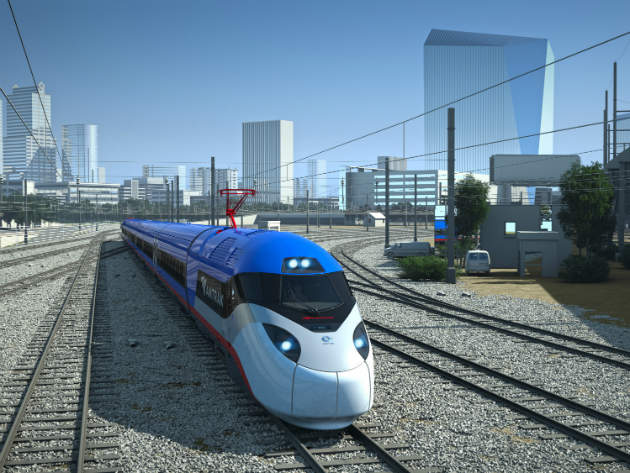

The US Northeast Corridor (NEC) stretches across approximately 457 miles, linking the economic heartlands of Boston, New York City, and Washington, D.C. Its importance is growing; Amtrak’s Acela service has witnessed an increase from 2.4 million passengers in 2002 to 3.5 million in 2014, while annual ridership on the NEC as a whole – including other commuter services – is 750,000 daily and 260 million trips annually.
“The north eastern US is one of the largest economic generators [in the country],” says Amtrak’s senior vice president of strategic rail initiatives, Mark Yachmetz. “The importance of the railroads is in connecting the major cities.”
The growth poses some important questions: how do you keep up with demand? And, how to ensure the service is fit for the future? Enter Alstom’s new Avelia Liberty high speed train, as well as Amtrak’s overall NEC transformation project.
Amtrak’s current service uses the Acela trains, but the Liberty will, says Alstom, carry up to 33% more passengers, once they enter revenue service in 2021. “[It also has} 20% less energy consumption, 30% reduction in train weight resulting in less wear and tear on the infrastructure, and the ability to reach speeds up to 186mph in its current configuration,” says Alstom’s North American vice president for marketing and strategy, Scott Sherin. However, the train will initially operate at 160 mph.
A train fit for the future?
One of the Liberty’s key selling points is its ability to change to fit the times. The speed can be increased to 350 km/h, although that is dependent on the infrastructure on which it is running.
However, what both companies are pushing is “anticipative active tilting”, or, in other words, traversing curves at higher speeds than is currently possible. For the NEC, that is paramount.
“We operate on a 19th century alignment,” explains Yachmetz. “The cities of the northeast grew around our railroad, which was created, quite frankly, when a high speed train was 50-60mph, not 200mph.
“So, we have a significant amount of curvature on the route, which means that being able to operate relatively fast in that kind of environment is really a challenge.” Some of the infrastructure is up to 100 years old, adds Yachmetz, “so we need to accommodate that and also the ongoing challenge of operating in a very dense rail environment”.
The Liberty will tilt up to seven degrees, helping Amtrak solve the question of “how do you fit the new service into those challenges?”, adds Yachmetz.
This jump in technology, from the Acela model, will also mean a new training programme for Amtrak, including engineers, drivers and maintenance staff, supported by an agreement with Alstom for technical support and spare components.
Sherin says: “With journey time reduction and an increased number of seats, the Liberty will drive [a further] increase in ridership on the NEC. This will reduce the number of flights between cities like Washington, D.C, New York City and Boston, and reduce the traffic on Interstate 95 that connects those cities.”
For Amtrak, it is very much about understanding how the Liberty will run over the whole of its 30-year life, not just the immediate changes it will provide when it takes to the tracks in a few years.
The NEC’s transformation
Yachmetz says they are “hopeful” that during these thirty years, “we will have stretches of track that we can rebuild to operate at the top speed and reduce the journey times between those three major markets”, which is key to Amtrak’s vision for how the NEC will look and feel decades from now.
Between 1976 and 1998, $4bn was invested in the route, but it’s testament to how quickly the sector is growing and passenger demands are changing that in 2010, Amtrak unveiled a “master plan” for high speed rail. A 2012 Amtrak report listed infrastructure age and condition as “major considerations”, as well as taking into account that a large percentage of the Northeast population lives within 25 miles of the railway, further underlining its importance to the regional economy and communities it serves.
“The ultimate vision, to have a high speed railroad, [will have to sit alongside] our [other] services, because it's too important to the regional economy, so we have to maintain the services,” Yachmetz adds.
The “vision” includes two overlapping programmes: upgrades to existing infrastructure – financed in part by a $2.45bn loan from the Federal Railroad Administration’s railroad rehabilitation and improvement financing initiative – and the high-speed rail programme, which is expected to cost $151bn and could be completed by 2040.
Infrastructure work is already underway, including at Washington Union Station, where the concourse is getting an overhaul.
Yachmetz is confident of making significant progress next year; at the moment Amtrak is waiting on the completion of federal environmental studies, although they are “nearly complete”. It’s also important, he adds, that both major political parties in the US are committed to investing in infrastructure.
“We’re doing station work at some of our key sites in Washington and New York,” Yachmetz explains, “and we are also going to look for reliability improvements, [including] upgrading tracks and building new train platforms, as the growth in commuter traffic is starting to impact the reliability of our inter-city trains.”
For now, there’s plenty to keep minds occupied. For the Liberty train, as well as station upgrades, Yachmetz and his team are confirming final design specs. “We’re all moving towards a goal of everything being in place by 2020,” he says, “when we being the revenue service of the Avelia Liberty. That's a pretty aggressive schedule.”
In many ways, the NEC is similar to other ageing routes across the globe; growth in passenger numbers and no sign of demand slowing down. It’s another example of how rail is living in an age of renewal.



